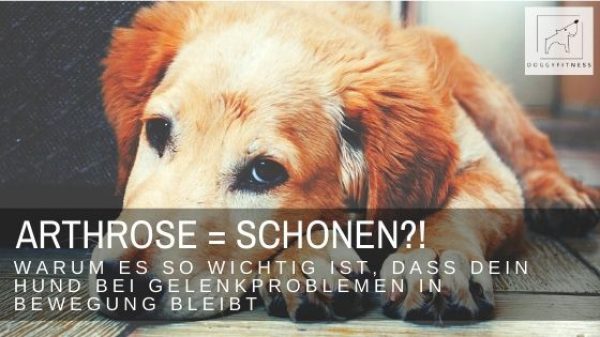When dog owners receive a diagnosis of osteoarthritis in their dog, they are usually unsure what is still good for their dog in terms of exercise. The first thought is usually that the dog must now be completely spared in order to prevent progression of the arthritis. However, this is not correct and can even be harmful for your dog.
What happens if you completely rest your dog with osteoarthritis and other joint diseases
Joints need movement to ensure nutrition of the cartilage. This is due to the fact that the nutrients reach the cartilage by means of a pumping movement via the synovial fluid. This is caused by the movement of the joint. If there is no movement, the cartilage is no longer sufficiently nourished. As a result, further osteoarthritis develops.
In addition, the joint fluid changes its consistency and becomes viscous if a joint is not moved sufficiently. The ligaments, tendons and muscles are also affected and joint mobility is restricted. The muscles break down, which in turn puts additional strain on the joints. You see, with complete rest or too little exercise, your dog very quickly gets into a vicious circle. This entails a progression of the arthrosis.
It is clear, then, that complete sparing of joint arthritis cannot be the means of choice to prevent progression of the arthritis and provide meaningful support for the dog. But what is the right way?
Keep moving – but adapted to the state of health
Adapted movement is the magic word. I know it’s a stretchy term and not very tangible because it’s not just a number you can throw around in a blanket way. Because every dog is different.
Basically, the daily exercise of your dog should be adapted to his state of health. For example, if you have joint disease, it’s a good idea to stop taking your dog on long walks twice a day. It is better to take several shorter walks throughout the day. This has the positive effect that your dog is not so much exhausted and at the same time the recovery period is significantly shortened.
In this way, you manage to ensure the necessary movement despite osteoarthritis. As I said, you can’t give a blanket value here for how long the individual walks may be. Here you really have to approach and see what is good for the dog.
“But my dog runs his big lap despite arthritis and has fun doing it, too!”
Sure, your dog has no sense of reason! The statement that dogs literally run until they drop and go beyond their limits despite severe joint problems I hear not at all rarely. This is simply because our dogs do not have a rational mind. Your dog isn’t thinking, “I better go home now or my knee will hurt again tomorrow.” Or “Nah, I better not play so wild with my dog buddy, or I’ll barely be able to get up again tomorrow.”.
We have to do this job for our dogs and it is the responsibility of us as dog owners to be reasonable for our dogs. This does not mean to regulate everything and not to allow the dog anything. A healthy balance is always important. Depriving the dog of his favorite activities altogether to ensure that his health is sufficiently taken care of is not sensible either. Then we have a dog that certainly doesn’t do anything that could harm it, but we also have a dog that possibly becomes depressed because its quality of life is simply very negatively affected.
So it’s always a matter of weighing things up accordingly.
Are walks alone enough to stop the progression of osteoarthritis?
In any case, the walks are a very important factor. In addition, it is helpful to support your dog specifically with various movement exercises. This is like regular gymnastics to maintain and promote musculature and flexibility. Just like a human physical therapist would recommend if you have joint problems. By the way, here I can recommend my Arthrosfit self-learning course for dog owners. There you will learn specific movement exercises for your dog that will keep him moving when he has osteoarthritis: ARTHROSEFIT MOVEMENT TRAINING.
Conclusion – Osteoarthritis = Spare?!
Sparing is by no means the sole solution. It is important to maintain some movement and mobility of your dog, thus preventing the progression of joint problems. Adapted walks – more frequent, but shorter – and additional targeted exercise training are optimal to move your dog properly and sufficiently with joint problems, without overloading him and without letting the joints “rust” by excessive sparing.
All the love, your Tina!
Dieser Beitrag ist auch verfügbar auf:
Français (French)
Deutsch (German)
Español (Spanish)















